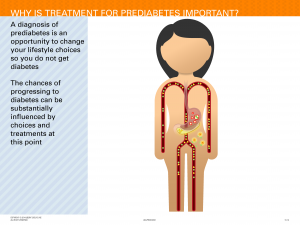Pre diabetic patients
During Prediabetes, the body’s Blood Glucose Level is higher than normal but do not reach Diabetic levels,
So, What is really happening inside the body?

Normally, our blood glucose level is under the control of many factors and hormones, but the main directly affecting hormones are Insulin and glucagon.
They have 2 opposite actions, through which they can regulate our blood glucose level in both fasting and feeding states.
Insulin is secreted from beta cells from clusters of Langerhans of the pancreas, which is a type of cells responsible for insulin synthesis and secretion, It is secreted in response to high blood glucose level“During feed state”.Glucagon is secreted from alpha cells of the pancreas, It is secreted in response to low insulin levels (Directly) and low blood glucose levels(indirectly).
Normal blood glucose level

Normal People:
- Fasting: (72-99)mg/dl
- Post-meal by 2 hours: maximum 140 mg/dl
Pre diabetic Patients:
- Fasting: (100-125)mg/dl
- Post-meal by 2 hours: (140-199)mg/dl
Diabetic Patients:
- Fasting: (Greater than 126)mg/dl
- Post-meal by 2 hours: (Greater than 200)mg/dl
For more clarification, If you are prediabetic your body is between normal and diabetes.
Unfortunately, this state mostly isn’t easily detected☹.
In a sample of 892 subjects, A study is published in primary care diabetes journal in February 2019:
They found an approach to be able to detect prediabetics early and prediabetes prevalence through (PRESS, Prediabetes Risk Evaluation Scoring System),160 out of 892 where prediabetics (approximately 17.93%), So PRESS, is a simple and non-invasive system that can be used for undiagnosed pre diabetic patients.
Pre diabetes causes
When the body starts not to use glucose properly or can not use it, The blood glucose levels start to get out of normal.

Insulin should be secreted and work when we have eaten a meal to lower our blood glucose level. Thus, either there is a low insulin level to fulfill the glucose level or there is enough Insulin but your cell’s response is resisting it, you start to show symptoms of prediabetes.
Pre diabetes symptoms
In most cases, there are no symptoms, but through observation, it was found that skin darkens in certain areas such as Knees, Elbows, Neck, and Knuckles.
Early symptoms to warn that you are prediabetic and diabetes mellitus type 2 is on the way:
- Increased urination frequency.
- Increased thirst.
- Feeling hungry.
- Feeling tired.
- Blurred vision.
- Slowly healing cut and wounds.
- Starting to wound without feeling it, due to decreased touch or trauma sensation.
- Numbness or tingling of feet and hands.
- Darkening of the skin.
- Easily infected by fungal infections and feeling itchy, especially in the groin area, which is the area between your legs.
Prediabetes risk factors

- Weight, Being obese or overweight is an indication of food or calories over intake, Which exceeds your body requirements, Increases Insulin Resistance.
- Your Food Type: Eating red or processed meat, sweetened beverages, Food rich in fats,…Etc
- Waist size: large waist size greater than 40 inches for men and 35 for women.
- Abdomen obesity.
- Family history: If you have a parent or sibling who has diabetes type 2, be aware you are at risk.
- The race you belong to could put you at risk due to genetics, races such as Hispanics, Native Americans, African Americans, Pacific Islanders, and Asian Americans are common to be risky.
- Physical inactivity.
-
Age; Being above 40-45 years makes you labile to risk.
- Sex; It is found out that girls and women are at higher risk than boys and men in developing Pre-diabetes and Diabetes Type 2.
- Sleep; When you are unable to sleep or missing with your normal sleeping time and rhythm, The Insulin resistance increase and normal body biological and chemical processes are not working normally.
- Polycystic ovary syndrome: A condition of abnormally high male hormones in females, Which disrupts her menstrual cycle Increases hair growth, lead to obesity and insulin resistance.
-
Gestational Diabetes: Is diabetes occurring during pregnancy for a number of women, It could be a risk for developing prediabetes and type 2 diabetes






Nice